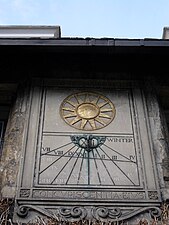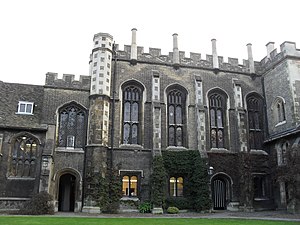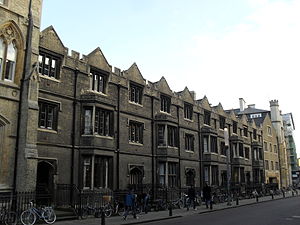Corpus Christi College, Cambridge
| Corpus Christi College
| |||||||||||
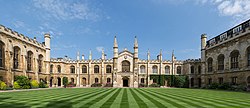 Corpus Christi College New Court | |||||||||||
|---|---|---|---|---|---|---|---|---|---|---|---|
 | |||||||||||
| Master: | Christopher Kelly | ||||||||||
| Website: | corpus.cam.ac.uk | ||||||||||
| |||||||||||
| Location | |||||||||||
| Grid reference: | TL44835821 | ||||||||||
| Location: | 52°12’11"N, -0°7’5"E | ||||||||||
Corpus Christi College (the full name of which is "The College of Corpus Christi and the Blessed Virgin Mary") is a constituent college of the University of Cambridge.[1] From the late 14th century to the early 19th century, the college was also commonly known as St Benet's College.
The college is notable as the only one founded by Cambridge townspeople: it was established in 1352 by the Guild of Corpus Christi and the Guild of the Blessed Virgin Mary,[2] making it the sixth-oldest college in Cambridge. With around 300 undergraduates and 200 postgraduates, it also has the second smallest student body of the traditional colleges of the University, after Peterhouse.
The College has traditionally been one of the more academically successful colleges in the University of Cambridge. In the unofficial Tompkins Table, which ranks the colleges by the class of degrees obtained by their undergraduates, in 2012 Corpus was in third position, with 32.4% of its undergraduates achieving first-class degrees. The college's average position between 2003 and 2012 was 9th, and in the 2022 rankings it was placed 9th.
Corpus ranks among the wealthiest Cambridge colleges in terms of fixed assets, being exceptionally rich in silver. The College's endowment was valued at £90.9 million at the end of June 2017, while its net assets were valued at £227.4 million.[3]
History
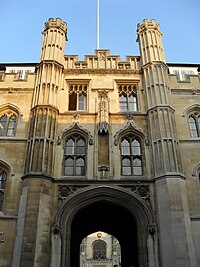
Foundation
The guild of Corpus Christi was founded in Cambridge in 1349 by William Horwode, Henry de Tangmere, and John Hardy[4] in response to the Black Death. They determined to found a new college in the University of Cambridge, the sixth in the University's history.[4] Later the same year the new guild merged with an older guild, the Guild of the Blessed Virgin Mary, which had been devastated by the Plague. The united guilds acquired land in the centre of town and their patron, the Duke of Lancaster,[4] applied to King Edward III for a licence to found a new college, which was granted in 1352.[5]
Construction of a single modest court near the parish church began immediately and in 1356 it was ready to house the Master and two fellows.[5] The college's statutes were drawn up in 1356.[6] The united guild merged its identity with the new college, which acquired all the guild's lands, ceremonies, and revenues.[4] The grandest of these ceremonies was the annual Corpus Christi procession: a parade through the streets to Magdalene Bridge, the host carried by a priest and several of the college's treasures carried by the Master and fellows, before returning for an extravagant dinner. The parade continued until the Reformation, when the Master, William Sowode, put a stop to it in 1535.[4] The college continues to have a grand dinner on the feast day of Corpus Christi, the Thursday after Trinity Sunday.
The newly constructed court could house 22 fellows and students. The statutes laid down the rules governing the behaviour of fellows only. Students were not part of the foundation at this stage and would not come within the scope of the statutes for another 200 years.
Name
The college's most formal name is the 'College of Corpus Christi and the Blessed Virgin Mary in the University of Cambridge', usually abbreviated to 'Corpus Christi College'. From the early 16th century, it was also known as Benet or St Benet's College, from the nearby St Bene't's Church, associated with the founding guild of Corpus Christi. Both the college and the church stand on Bene't Street.[7] Until the late 16th century, the church served as the college chapel, although St Botolph's was also used for some services. When Thomas Cosyn was master of the college in the late 15th century, a gallery was built which linked the college to St Benet's church.[8]
By the later 16th century, Benet College became the name most commonly used, as "Corpus Christi" was deemed to have a rather Roman Catholic flavour. This preference continued until the early 19th century.[9]
Mediæval period
In its early centuries, the college was relatively poor[2] and so could not construct new buildings; thus Old Court has survived to the present day. It had no chapel, so the members worshipped in St Bene't's Church next door. From the late 14th century through to the 19th century, particularly during the Reformation when Roman Catholic references were discouraged, Corpus was known as St Benet's College.[4] By 1376 it possessed 55 books, and many more would be donated or bequeathed over the succeeding centuries, including, those bequeathed by Thomas Markaunt and, most significantly, those donated in the 16th century by Archbishop Matthew Parker, who is celebrated by the college as its greatest benefactor.[2]
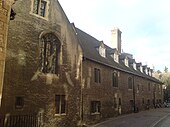
During the Peasants' Revolt in 1381, the college was sacked by a mob of townspeople (and apparently some students) led by the mayor[2] which, according to the college, carried away its plate as well as its charter to be burned while gutting the rest of the college buildings.[10] Corpus was the only University college, although by no means the only University building, to be attacked.[10] The revolt, which ironically took place during the Corpus Christi week, focused on the college as centre of discontent due to its rigid collection of "candle rents".[2] The college claimed £80 (roughly £50,000 in modern terms) in damages.
In 1460 during the Wars of the Roses, the college paid for armaments including artillery and arrows, and protective clothing to defend the college's treasures from a "tempestuous riot".
Elizabeth, Duchess of Norfolk, and her sister Lady Eleanor Botelar née Talbot, who is believed by some to have been secretly married to Edward IV,[11] endowed the college with scholarships in the 1460s and financed repairs to the college buildings.[4] As a monument a 'talbot', the heraldic supporter of the Talbot family, was placed on the gable of Old Court and can still be seen today. At the same time the Master, Thomas Cosyn, built the college's first chapel and a passageway between Old Court and St Bene't's Church.[6] Over the next few centuries, garret rooms were added in Old Court increasing student numbers.[4]
Reformation
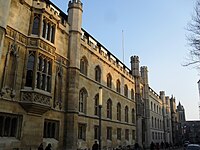
The Reformation received strong support in Cambridge. In the religious tumult, the college produced adherents and indeed martyrs to both traditions. William Sowode was a reforming priest, who cancelled the Corpus Christi procession; on the other side, Richard Reynolds of the College was executed for refusing to subscribe to the Act of Supremacy under Henry VIII; while Thomas Dusgate was burned as Protestant under the same King, and George Wishart likewise in Scotland.[6]
It was during the reign of Henry VIII that Matthew Parker (later Archbishop of Canterbury) became Master of Corpus Christi. He donated his unrivalled library to the college, much silver plate and its symbol, the pelican. In order to ensure the safety of his collection Parker inserted into the terms of his endowment one which stated that if any more than a certain number of books were lost, the rest of the collection would pass first to Gonville and Caius College, Cambridge and then (in the event of any more losses) to Trinity Hall, Cambridge. Every few years, representatives from both of those colleges ceremonially inspect the collection for any losses.[6]
Parker placed a similar condition on the silver that he bequeathed to the college and these stipulations are part of the reason why Corpus Christi College retains to this day the entirety of the library and the silver collection: they were unable to sell off (or melt down) the less valuable parts of either collection without losing both. (Parker's assiduousness in his acquisition of books and manuscripts has been suggested as an origin of the phrase "Nosey Parker".[12]) Parker was forced to resign as Master in 1553 by the accession of Mary I but was elected Archbishop of Canterbury upon the succession of Elizabeth I.
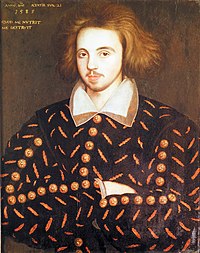
The playwright Christopher Marlowe is perhaps the college's most-celebrated son, having matriculated to Corpus in 1580. Although little is known about his time there, it is often believed that it was during his study for his MA that he began his work as a spy, a claim based on only a single cryptic statement by the Privy Council.
In 1952, a portrait of a man "in the 21st year of his age" was discovered during renovation work at the college. As the painting is dated 1585, the year Marlowe was 21, it has been claimed as a portrait of the playwright, of whom no other known portrait exists.[13]
As the number of students rose a bigger chapel became necessary. In 1578 Sir Nicholas Bacon, Lord Keeper of the Great Seal, who had already endowed several scholarships to the college, donated £200 (roughly £30,000 now) for the construction of a new chapel.[6] This sum was not nearly great enough to build a chapel, and despite the efforts of the Master and fellows, the project outran estimates and nearly bankrupted the college. The college sold all of its silver, apart from the gifts from Parker, and the building work was not completed until 1662. Other contributors included Elizabeth I and Sir Francis Drake.[6]
Owing to disputed appointments to the Mastership, Elizabeth I imposed the appointment of John Jegon as Master in 1590.[2] The college did not appoint its own Master for some time. Although not the college's choice, Jegon extricated the college from its financial difficulties by instituting fellow commoners, who would stay for one or two years and were never technically members of the University. Their parents were required to pay with a silver cup or tankard, which would then be melted down. The next notable Master was Henry Butts, who was also Vice Chancellor of the University. When the plague returned to the city and the rest of the University had fled, Butts stayed at his post and tried to limit the pestilence while staying alone in the college. He was unrewarded for his bravery and this experience seems to have had a terrible effect on him. In 1632, when Butts failed to turn up to deliver the University Sermon on Easter Day, he was found to have hanged himself.[2][6]
Jacobean period
Corpus maintains an impressive collection of silver as it was the only college not to sell its silverware in support of either side during the Civil War.[2] That, and its unrivalled collection of manuscripts and massive collection of rare wines and ports, fuels rumours that it is Cambridge's richest college per student. This is a moot point, since these assets cannot be sold and the majority of them cannot be valued.
Unlike other Oxbridge colleges, the college managed to remain neutral during the Civil War. This was due to the ministration of Richard Love who was Master throughout the Civil War and the Commonwealth. According to college legend, the silver plate was distributed to the fellows to keep it from being requisitioned by the warring factions.[2][6] When the fighting finished the plate was returned and melted down to pay for repairs. Twelve college heads were removed from their posts, but Love and three others were retained. The college also escaped the worst excesses of the puritan Commonwealth. When William Dowsing inspected the college he found "nothing to amend". St Benet's Church was not so lucky and indeed there was much disturbance in the fellowship as many were forced out and reinstated as circumstances changed through the period.[6]
Age of Enlightenment

In 1688, the college was attacked once again by a mob, this time with an anti-Papist bent. They made for the rooms of the bursar, Clement Scott, whom they suspected of popery. He hid himself from the mob so they destroyed his books and papers. The college continued to grow throughout the 18th century and did produce several distinguished scholars and clergymen including the so-called Benedictine Antiquaries, a dozen or so men all well known for antiquarian research including such figures as Richard Gough and William Stukeley.[2][6]
In the 1740s, Archbishop Thomas Herring left £1000 for the rebuilding of the college and this led to several abortive attempts to start construction. In 1770 Matthias Mawson, former Master and Bishop of Ely, bequeathed £3000 to defray the costs of demolishing and rebuilding the college but this was not enough. It was not until 1822 when £55,000 had accrued in the rebuilding fund that efforts started. William Wilkins, who had recently completed major works at Downing, King's, and Trinity, was appointed architect and the New Court was completed in 1827 in a neo-gothic style.[2] This involved the demolition of several buildings, including the Elizabethan chapel. The chapel currently standing in New Court is part of the 19th-century construction. Completion of a new, larger court allowed for many more students and numbers increased from 48 to 100.
Victorian Period

During the 19th century the college became associated with the Evangelical religious movement.[6] In the 1860s its popularity grew so great that it became the third largest college in Cambridge. Corpus was always strongly clerical as, at the time, all the fellows had to be in Holy Orders of the Church of England. For many years the majority of the college's graduates went on to be clergymen.[14] However, the University was changing quickly; with the repeal of the Test Acts and Roman Catholic relief allowing Catholics to join the University for the first time. The syllabus also broadened and the fellow commoners faded away. In 1882, fellows were allowed to marry for the first time.[15] This meant that being an academic fellow could be a lifelong career rather than a stop gap between study and becoming a country parson. Consequently, the demographics of the college fellowship changed significantly during this time. The first married fellow was Edward Byles Cowell who was the first professor of Sanskrit.[15] Later in the century the college fell on hard times and the number of undergraduates dropped to fewer than 50.[15] It was around this time that the infamous 'Chess Club' was founded. Despite their impeccant name they became notorious for hard drinking and partying. They were outlawed in the 1980s for their activities.
Edwardian period
Colonel Robert Caldwell]] was made Master in 1906 and was the first ever layman to be appointed to the post.[2] He changed the policy of the college with regard to admittance of fellows and undergraduates, encouraging men from other colleges and outside Cambridge to become fellows. The college was no longer chiefly training men for the clergy.[2] Student numbers increased significantly and a new undergraduate Library named after one of the Burgesses for the University, Geoffrey Butler[2] was completed. The college also began construction of its sports grounds in west Cambridge in 1939.
Second World War
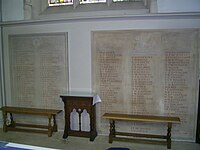
During the Second World War, the Master of the College was Sir Will Spens, who was also Regional Commissioner of Civil Defence for the Eastern Region: had the Germans Hitler invaded, he would have been in charge of running Eastern England. The college housed various government departments whilst the then Master was also the Regional Commissioner. Corpus would have hosted the organisation which may have been required to act as an autonomous government authority if central government was incapacitated.[16] This has led to a persistent rumour of a network of tunnels under the college excavated for this purpose. While there are extensive wine cellars, there is no evidence of such tunnels. During the war there were fewer undergraduates in residence, but the space was taken up by cadets and officers of the armed services taking short courses. Due to the increase in student numbers in the 1930s, Corpus is one of the few British institutions to have lost more members in the Second World War than in the First. Their names are inscribed in the Chapel.
Modern period
During the 1960s, central heating was extended across the entire college campus. Women were also allowed to join the college Chapel Choir and dine in hall. In 1963, the college's first bar was opened in New Court.[2] In 2008, it was moved to Library Court and the old bar was converted into a post room, staffroom and a graduate student common room.
In 1962, the college approved the conversion of the Leckhampton site to allow for more accommodation for fellows and postgraduate students.[2] Further properties were purchased adjacent to the site and a new building, the George Thomson building, named in honour of a former Master, was completed in 1964.
In 1983, women were first admitted as undergraduates.[2] They had been able to become research students and Fellows for a few years before this. In the same year, the college completed building work in Botolph Court, adding further undergraduate accommodation. Similar renovation work was completed in Bene't Court above the Eagle pub in the 1990s along with the creation of the Robert Beldam building.
Buildings
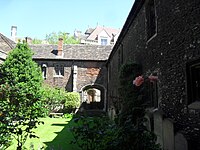
Old Court
Built in the 1350s, Old Court contains some of Cambridge's oldest buildings, and retains many of its original features, such as sills and jambs used to hold oil-soaked linen in the days prior to the arrival of glass. The court is the oldest continually inhabited courtyard in the country (a claim disputed by Merton College, Oxford, which says the same of its Mob Quad). It is possibly built from the core of an even older building. Four sided, it typifies the model of construction of the colleges in Oxford or Cambridge. A passageway connects Old Court to Bene't Street. Due to its age the rooms are large and contain antique furniture but lack basic facilities and plumbing. In 1919 the ivy was removed from Old Court and a roughcast rendering was put in its place, followed by a major restoration in 1952 paid for by donations from old members.
During the summer months students are permitted to sit on the lawn in Old Court and garden parties may be held whereas, like other Oxbridge colleges, normally only fellows are allowed to walk on the lawns.[17] There is a large plaque, on the northern wall, dedicated to Christopher Marlowe and John Fletcher, both famous playwrights who studied at Corpus. Standing inside Old Court one can see the tower of St Bene't's Church, the oldest building in Cambridge, and the Old Cavendish Laboratory where the structure of DNA was solved by Watson and Crick[18] and groundbreaking work on the structure of the atom was conducted by J. J. Thomson and Ernest Rutherford.[19] Around 1500, the master, Thomas Cosyn built a brick gallery which connects Old Court with St. Benet's Church; the gallery is now part of an Old Court room set.
St Bene't's Church
- Main article: St Bene't's Church

The adjacent St Bene't's Church served as the college's chapel until 1579[20] when one was built specifically for the purpose. The college remains the patron.[6] The tower of St Bene't's is the oldest building in Cambridge dating back to before the Norman Conquest, built in the late Anglo-Saxon period.[21] It is also notable for being the birthplace of the practice of ringing the changes, which was started by Fabian Stedman, a parish clerk, in 1670.[21]
New Court
New Court (completed 1827) was designed by William Wilkins, who is buried in the vaults of the college chapel. Although he went on to design the curtain wall in front of King's College, Cambridge and the National Gallery in London, he considered Corpus to be his favourite work and requested to be buried in the Chapel. A plaque commemorating him is in the entrance to the Parker Library within the court. This court also housed the Butler Library, the college's student library, directly below the Parker Library. Upon completion of the building works in 2008, it relocated to the new Library Court and was renamed the Taylor Library after the project's main benefactor John Taylor. Many of the more precious volumes in the Parker Library are now protected in vaults in what used to be the Butler Library. New Court was built to symbolise the harmony between the mind, body and soul with the Parker Library on the right representing the mind, the Hall and kitchens on the left representing the body and the Chapel in the centre representing the soul.
The Chapel
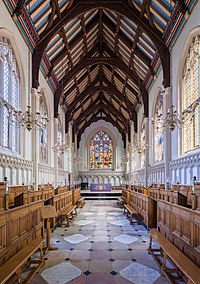

The current Chapel is the third the college has had and was completed in 1827 along with the rest of New Court. It was also designed by William Wilkins, but includes some mediæval glass and features, including the fellows' stalls, several memorials and the floor of the older Elizabethan Chapel, which was demolished in the construction of New Court. The first four stained glass windows date to around 1500 and are believed to come from the Abbey of Mariawald in Germany which had been dissolved by Napoleon.[22] Some of the pews and the pulpit of the Elizabethan chapel can now be found in St Andrew's Church, Thurning, Norfolk.[23] Hanging on the south wall is a depiction of the Madonna and Child by 17th-century artist Elisabetta Sirani. The Chapel also features an icon, something unusual for an Oxbridge college. The depiction of the Christ Pantocrator was painted for the college by a Greek Orthodox monk and is used as a focus for meditation.
The Chapel was extended in the late 19th century to make room for increasing student numbers, and the chancel dates from this time. The ceiling, which had been a stone fan-ribbed vault like the ceiling of the college gatehouse, was replaced by the painted wooden ceiling still in place today.
The Parker Library

The collection was begun in 1376 and much improved by a bequest from Matthew Parker, the college's Master between 1544 and 1553, who as Archbishop of Canterbury formed a fine collection of manuscripts from the libraries of dissolved monasteries.
The Parker Collection is one of the finest and most important collections of mediæval manuscripts in the world. The historian James D. Wenn has suggested that Parker may have enjoyed the protection of Sir Rowland Hill of Soulton, Shropshire, during his period of disfavour under Mary I, when this collection would have been in danger, along with Parker himself; Hill was the publisher of the Geneva Bible and joined Parker as a Commissioner for Ecclesiastical Cases in 1559.[24]
The building was completed in 1827 in the construction of Wilkin's New Court. Currently the collection comprises over 600 manuscripts, around 480 of which were given by Parker, who also donated around 1000 printed volumes.
Its most famous possession is the St Augustine Gospels, probably brought to England by St Augustine, when he was sent by Pope Gregory I to convert the people of Britain in 598 AD. The Gospels are still used in the enthronement of the Archbishops of Canterbury today and are transported to and from Canterbury by the Master and college representatives.[25] It also contains the principal manuscript of the Anglo-Saxon Chronicle, works by Matthew Paris, and Chaucer's Troilus and Criseyde, to name only a few.
In a joint venture between the college, the University Library and Stanford University in the United States of America the entire collection was digitised.
Pictures
-
The sundial in Old Court
-
The Dining Hall seen from Old Court
-
The terraced houses between New Court and the Taylor Library
-
The entrance to the college
Outside links
| ("Wikimedia Commons" has material about Corpus Christi College, Cambridge) |
References
- ↑ Wale, Kirstie (2022-06-27). "Corpus Christi College" (in en). https://www.undergraduate.study.cam.ac.uk/colleges/corpus-christi-college.
- ↑ 2.00 2.01 2.02 2.03 2.04 2.05 2.06 2.07 2.08 2.09 2.10 2.11 2.12 2.13 2.14 2.15 2.16 "History". About. Corpus Christi College Cambridge. http://www.corpus.cam.ac.uk/about-us/history/.
- ↑ Corpus Christi College, Cambridge. "Recommended Cambridge College Accounts (RCCA)". https://www.corpus.cam.ac.uk/sites/default/files/downloads/accounts_2016-2017.pdf.
- ↑ 4.0 4.1 4.2 4.3 4.4 4.5 4.6 4.7 Lamb, John (1831). Master's history of the College of Corpus Christi and the blessed Virgin Mary in the University of Cambridge: with additional matter and a continuation to the present time. Cambridge University Press. OCLC 13664738. https://books.google.com/books?id=sI9PAQAAMAAJ.
- ↑ 5.0 5.1 "600th Anniversary Celebrations of Corpus Christi College, Cambridge". History Today. http://www.historytoday.com/MainArticle.aspx?m=18429.
- ↑ 6.00 6.01 6.02 6.03 6.04 6.05 6.06 6.07 6.08 6.09 6.10 6.11 A History of the County of Cambridgeshire - Volume 3 pp 371-376: The colleges and halls: Corpus Christi (Victoria County History)
- ↑ William Harrison, Georges Edelen, The Description of England (London: Courier, 1994), p. 77
- ↑ Derek Beales, Geoffrey Best, History, Society, and the Churches (2005), p. 75
- ↑ Christopher N. L. Brooke, "The dedications of Cambridge colleges and their chapels", in Patrick Zutshi, ed., Mediæval Cambridge: Essays on the Pre-reformation University (Woodbridge: The Boydell Press and Cambridge University Library, 1993), p. 10
- ↑ 10.0 10.1 Oman, Charles (1906). The Great Revolt of 1381. Clarendon Press. ISBN 1-85367-045-6. https://archive.org/details/greatrevoltof13800omanuoft.
- ↑ John Ashdown-Hill, Eleanor, the Secret Queen. History Press, 2009
- ↑ "Biographies – Matthew Parker". Corpus Christi College. http://www.corpus.cam.ac.uk/ndex.php?option=com_content&view=article&id=115&Itemid=45.
- ↑ Logan, Robert A. (2017) (in en). Christopher Marlowe. Routledge. pp. Chaper 4. ISBN 9781351951647. https://books.google.com/books?id=jr5BDgAAQBAJ&q=Marlowe+portrait+%22Corpus+Christi%22&pg=PT80. Retrieved 8 August 2019.
- ↑ "The letter". Corpus Christi College, Cambridge. http://www.corpus.cam.ac.uk/wp-content/uploads/old/Corpus-Letter-93-FINAL.pdf.
- ↑ 15.0 15.1 15.2 Rackham, Oliver (2013). A Short History of The College of Corpus Christi and the Blessed Virgin Mary in Cambridge. Corpus Christi College, Cambridge.
- ↑ Richard Newman. "New Court and Master's Garden, Corpus Christi College, Cambridge. An Archaeological Investigation". Cambridge Archaeological Unit. https://www.corpus.cam.ac.uk/sites/default/files/archaeological_excavation_full_report.pdf.
- ↑ "Corpus Christi Website – Old Court History". Corpus Christi College. http://www.corpus.cam.ac.uk/about-corpus/maps-and-tours/take-a-virtual-tour/223.
- ↑ "DNA: 50 Year of the Double Helix". MRC Laboratory of Molecular Biology. http://www2.mrc-lmb.cam.ac.uk/dna2003.
- ↑ "History of the Cavendish". Dept of Physic, University of Cambridge. 13 August 2013. http://www.phy.cam.ac.uk/history/.
- ↑ "Corpus Christi Website – St Bene't's Church". Corpus Christi College. http://www.corpus.cam.ac.uk/about-corpus/maps-and-tours/take-a-virtual-tour/229.
- ↑ 21.0 21.1 "St Bene't's Church Website-St Bene't's Church". St Bene't's Church. http://www.users.zetnet.co.uk/psbski/cambuk/stbenets/stbenhis.htm.
- ↑ "Norfolk: Hingham, Parish Church of St Andrew". Corpus Vitrearum Medii Aevi: Mediæval Stained Glass in Great Britain. http://www.cvma.ac.uk/publications/digital/norfolk/sites/hingham/history.html.
- ↑ "Norfolk Churches". Norfolk Churches. http://www.norfolkchurches.co.uk/thurning/thurning.htm.
- ↑ Garnet as Emblem of Goodness: Philosophical architecture from Henry III to George III - YouTube
- ↑ "Corpus Christi Website – Parker Library Collections". Corpus Christi College. http://www.corpus.cam.ac.uk/about-corpus/maps-and-tours/take-a-virtual-tour/205.
- QCC staff. "University of Cambridge – Foundation dates of Colleges". Queens' College Cambridge. http://www.queens.cam.ac.uk/queens/misc/Coll-Dates-Cam.html.
Attribution
| Colleges of the University of Cambridge | |
|---|---|
|
Christ’s • Churchill • Clare • Clare Hall • Corpus Christi • Darwin • Downing • Emmanuel • Fitzwilliam • Girton • Gonville and Caius • Homerton • Hughes Hall • Jesus • King’s • Lucy Cavendish • Magdalene • Murray Edwards • Newnham • Pembroke • Peterhouse • Queens’ • Robinson • St Catharine’s • St Edmund’s • St John’s • Selwyn • Sidney Sussex • Trinity • Trinity Hall • Wolfson |
 |
